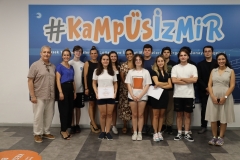
FACULTY OF BUSINESS
Department of International Trade and Finance
ITF 415 | Course Introduction and Application Information
| Course Name |
Financial Econometrics
|
|
Code
|
Semester
|
Theory
(hour/week) |
Application/Lab
(hour/week) |
Local Credits
|
ECTS
|
|
ITF 415
|
Fall/Spring
|
3
|
0
|
3
|
6
|
| Prerequisites |
None
|
|||||
| Course Language |
English
|
|||||
| Course Type |
Elective
|
|||||
| Course Level |
First Cycle
|
|||||
| Mode of Delivery | - | |||||
| Teaching Methods and Techniques of the Course | - | |||||
| Course Coordinator | ||||||
| Course Lecturer(s) | ||||||
| Assistant(s) | - | |||||
| Course Objectives | The primary objective is to introduce and teach a broad knowledge of modern econometric techniques commonly employed in the finance literature. Although seems a demanding quantitative background, to enhance the learning outcome, all examples can easily be applied through several software such as Eviews and RATS. The course can be utilized to support other disciplines such as financial economics, securities and investments. Finally the course presents a unique opportunity to better understand the sophisticated financial markets and provide students with skills to estimate and interpret models while developing intuitive grasp of underlying theoretical concepts. |
| Learning Outcomes |
The students who succeeded in this course;
|
| Course Description | Topics covered are: definition of econometrics and financial econometrics, classical linear regression model and its assumptions, univariate and multivariate models, cointegration models, modeling volatility and correlation and simulation models. |
|
|
Core Courses | |
| Major Area Courses |
X
|
|
| Supportive Courses | ||
| Media and Management Skills Courses | ||
| Transferable Skill Courses |
WEEKLY SUBJECTS AND RELATED PREPARATION STUDIES
| Week | Subjects | Related Preparation |
| 1 | Introduction | |
| 2 | Stylized facts regarding financial data and econometricsa) Distinguish between different types of data b) Describe the steps involved in building an econometric model c) Calculate asset price returns and accomplish simple tasks in econometric software | Chris Brooks, “Introductory Econometrics for Finance”, Second Edition |
| 3 | Klasik doğrusal regresyon modelia) Parametrelerin ve standart hatalarının tahminini yapabilmek için EKKY formülünün türetilmesib) Anlamlılık testi ve güven aralığı yaklaşımları ile hipotez testleric) Ekonometri paketlerinde regresyon modellerinin tahmini ve tek hipotezi testi. | Chris Brooks, “Introductory Econometrics for Finance”, Second Edition |
| 4 | Overview of the classical linear regression model a) Derive OLS formulae for estimating parameters and their standard errors. b) Test hypothesis using the test of significance and confidence interval approaches c) Estimate regression models and test single hypotheses in econometric software. | Chris Brooks, “Introductory Econometrics for Finance”, Second Edition |
| 5 | Further development and analysis of the classical linear regression model.a) Construct models with more than one explanatory variable b) Test multiple hypotheses using an Ftest and determine how well a model fits the datac) Estimate multiple regression models and test multiple hypotheses in econometric software. | Chris Brooks, “Introductory Econometrics for Finance”, Second Edition |
| 6 | Classical linear regression model assumptions and diagnostic tests a) Describe the steps involved in testing regression residuals for heteroscedasticity and autocorrelation b) Distinguish between the DurbinWatson and Breusch—Godfrey tests for autocorrelation c) Determine whether the residual distribution from a regression differs significantly from normality and investigate whether the model parameters are stable | Chris Brooks, “Introductory Econometrics for Finance”, Second Edition |
| 7 | Univariate time series modelling and forecasting a) Explain the defining characteristics of various types of stochastic processes b) Identify the appropriate time series model for a given data series and produce forecasts for ARMA and exponential smoothing models c)Evaluate the accuracy of predictions using various metrics and estimate time series models and produce forecasts from them in econometric software | Chris Brooks, “Introductory Econometrics for Finance”, Second Edition |
| 8 | Univariate time series modelling and forecasting a) Explain the defining characteristics of various types of stochastic processes b) Identify the appropriate time series model for a given data series and produce forecasts for ARMA and exponential smoothing models c)Evaluate the accuracy of predictions using various metrics and estimate time series models and produce forecasts from them in econometric software | Chris Brooks, “Introductory Econometrics for Finance”, Second Edition |
| 9 | Article Presentation | |
| 10 | Project topic selection | |
| 11 | Multivariate modelsa) Describe several methods for estimating simultaneous equations models and explain the relative advantages and disadvantages of VAR modelingb) Estimate optimal lag lengths, impulse responses and variance decompositions c) Conduct Granger causality tests and construct simultaneous equations models and VARs in econometric software | Chris Brooks, “Introductory Econometrics for Finance”, Second Edition |
| 12 | Modelling volatility and correlationa) Discuss the features of data that motivate the use of GARCH models and explain how conditional volatility models are estimatedb) Test for ‘ARCHeffects’ in time series datac) Produce forecasts from GARCH models d) Estimate univariate and multivariate GARCH models in econometric software using maximum likelihood | Chris Brooks, “Introductory Econometrics for Finance”, Second Edition |
| 13 | Modelling volatility and correlationa) Discuss the features of data that motivate the use of GARCH models and explain how conditional volatility models are estimatedb) Test for ‘ARCHeffects’ in time series datac) Produce forecasts from GARCH models d) Estimate univariate and multivariate GARCH models in econometric software using maximum likelihood | Chris Brooks, “Introductory Econometrics for Finance”, Second Edition |
| 14 | Simulation methodsa) Design simulation frameworks to solve a variety of problems in financeb) Explain the difference between pure simulation and bootstrappingc) Monte Carlo simulation d) Implement a simulation analysis in econometric software | Chris Brooks, “Introductory Econometrics for Finance”, Second Edition |
| 15 | Project submission | |
| 16 | Final Exam |
| Course Notes/Textbooks | Chris Brooks, “Introductory Econometrics for Finance”, Second Edition, Cambridge University Press, ISBN: 978-0-521-69468-1 Book Chapters and Powerpoint slides |
| Suggested Readings/Materials | Journal of Financial Econometrics Journal of Econometrics Journal of Applied Econometrics Econometric Reviews Journal of Empirical Finance Financial Times Wall Street Journal |
EVALUATION SYSTEM
| Semester Activities | Number | Weigthing |
| Participation |
1
|
10
|
| Laboratory / Application | ||
| Field Work | ||
| Quizzes / Studio Critiques | ||
| Portfolio | ||
| Homework / Assignments |
1
|
20
|
| Presentation / Jury |
1
|
30
|
| Project | ||
| Seminar / Workshop | ||
| Oral Exams | ||
| Midterm | ||
| Final Exam |
1
|
40
|
| Total |
| Weighting of Semester Activities on the Final Grade |
3
|
60
|
| Weighting of End-of-Semester Activities on the Final Grade |
1
|
40
|
| Total |
ECTS / WORKLOAD TABLE
| Semester Activities | Number | Duration (Hours) | Workload |
|---|---|---|---|
| Theoretical Course Hours (Including exam week: 16 x total hours) |
16
|
3
|
48
|
| Laboratory / Application Hours (Including exam week: '.16.' x total hours) |
16
|
0
|
|
| Study Hours Out of Class |
16
|
3
|
48
|
| Field Work |
0
|
||
| Quizzes / Studio Critiques |
0
|
||
| Portfolio |
0
|
||
| Homework / Assignments |
1
|
20
|
20
|
| Presentation / Jury |
1
|
22
|
22
|
| Project |
0
|
||
| Seminar / Workshop |
0
|
||
| Oral Exam |
0
|
||
| Midterms |
0
|
||
| Final Exam |
1
|
30
|
30
|
| Total |
168
|
COURSE LEARNING OUTCOMES AND PROGRAM QUALIFICATIONS RELATIONSHIP
|
#
|
Program Competencies/Outcomes |
* Contribution Level
|
||||
|
1
|
2
|
3
|
4
|
5
|
||
| 1 | To be able to identify and analyze problems in the field of trade and finance, and to develop solutions. |
|||||
| 2 | To be able to use the theoretical and practical knowledge gained in the field of International Trade and Finance. | |||||
| 3 | To be able to analyze the developments in global markets by using critical thinking skills. | X | ||||
| 4 | To be able to analyze and interpret data in the field of finance, commerce and economics by using information technologies effectively. | X | ||||
| 5 | To be able to acquire knowledge about the legal regulations and practices in the field. | |||||
| 6 | To be able to foresee and define the risks that could be encountered in the field of trade and finance and to take decisions to manage such risks. | |||||
| 7 | To be able to acquire and use verbal and numerical skills necessary for the nature of international trade and finance program. | X | ||||
| 8 | To be able to obtain, synthesize and report the information related to the fields of trade and finance. | X | ||||
| 9 | To be able to contribute to the solution of problems as individual, team member or leader. | |||||
| 10 | To be able to evaluate the issues related to the field with an ethical perspective and social sensitivity. |
|||||
| 11 | To be able to collect data in the areas of International Trade and Finance and communicate with colleagues in a foreign language ("European Language Portfolio Global Scale", Level B1). | |||||
| 12 | To be able to speak a second foreign at a medium level of fluency efficiently. | |||||
| 13 | To be able to relate the knowledge accumulated throughout human history to their field of expertise. | |||||
*1 Lowest, 2 Low, 3 Average, 4 High, 5 Highest
NEWS |ALL NEWS

Aiming for Poland
Izmir University of Economics (IUE) students made it to the finals of the ‘Research Challenge’ organized by the CFA Institute, one of

Sustainable Finance Summer School
Sustainable Finance Summer School, designed for high school students within the body of İzmir University of Economics, EKOSEM, was held on August

‘Regional Championship’ is the goal
The team of 5, consisting of students of Izmir University of Economics (IUE), made it to the finals in the ‘Research Challenge’

Reputable membership to IUE from the UK-based institute
The UK-based CFA Institute, which is considered one of the most respected institutions in the finance sector, has included the Department of

Prof. Küçüközmen gave a speech on the Cyber Risks to EKOTÜRK
Faculty member of IUE Department of International Trade and Finance, Prof. Küçüközmen commented on the cyber risks to EKOTÜRK TV.

Prof. Dr. C. Coşkun Küçüközmen said 'İzmir should be a Fintech Center'
One of the professors of our department, Prof. Dr. C. Coşkun Küçüközmen, in his interview with the 9 Eylül Newspaper, evaluated that

Prof. Dr. C. Coşkun Küçüközmen; “Filling up your car with ‘50 Lira gasoline’ cannot take you back home”
One of the professors of our department, Prof. Dr. C. Coşkun Küçüközmen evaluated the price hikes on fuel in an interview with

Prof. Dr. C. Coşkun Küçüközmen; 'Turkey Can End the War With Its Historical Power'
One of the professors of our department, Prof. Dr. C. Coşkun Küçüközmen evaluated the Ukraine-Russia war and its effects in a special



